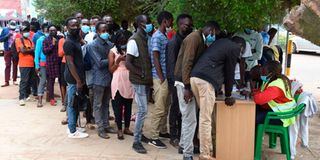Kenyan voting patterns need to be studied

Members of the public queue to register as voters during the Continuous Voters Registration by the Independent Electoral and Boundaries Commission in Eldoret, Uasin Gishu County on November 1, 2021.
What you need to know:
- There has been no comprehensive baseline study attempting to map out voter behaviour at the national level.
- It would be important to be able to better understand Kenyan voters as a whole, rather than imagining that the results of voting are only decided by ethnic strongholds or class solidarity.
At slightly more than a week to the August 9 elections, there is a lot of speculation about how different voting tiers will play out.
There’s the national versus county levels, all the way to the votes of different demographics such as youth, women, urban versus rural dwellers, religious groups or socioeconomic classes, among others.
To this day, there has been no comprehensive baseline study attempting to map out voter behaviour at the national level.
No current attempts have the requisite resourcing or wide-enough backing to make this the needed large-scale study that would help us understand one another better.
It would be important to do this study for several reasons.
The first is that all stakeholders – from the public and political parties to candidates and the media – would be able to better understand Kenyan voters as a whole, rather than imagining that the results of voting are only decided by ethnic strongholds or class solidarity.
The outcomes might be more complicated than that.
It would also be much easier to know what kind of voter information, sensitisation and education are needed for subsequent by-elections and the next general election to be more aligned to public needs.
A study like this would be able to unpack several deeply held ideas.
For example, many campaigns assume that a woman candidate would be an easy sell to women voters, but this is rarely the case for several reasons.
Voter apathy
Another long-held idea is that voter apathy is mostly a quantity expressed by youth aged between 18 and 35 years, consisting of a fixed set of behaviours culminating in refusal to cast a vote.
The only way to know if this is true would be a baseline study, with data being updated regularly ahead of the next elections.
It would also be important to understand both global explorations of this, as well as data on the African continent, and further see whether Kenyans align or deviate from this data.
Such a study would involve representation and participation from the Registrar of Political Parties, the Independent Electoral and Boundaries Commission, gender caucuses, media, civil society, academia, county and national governments, as well as the public.
Both online and offline data collection would ideally be done to have a hope of a significant statistical sample, considering our large population.
The study process could also be opened up and documented for the public as it unfolds, as part of wider political sensitisation and education.
Understanding voter behaviour comprehensively is central to any conversation around changing values, and mapping the growth of democracy in Kenya and the region.
As such, beyond August 9, any considerations for such a study would constitute a landmark decision for Kenyans, in growing our knowledge of who we are politically, and who we would like to be.
The writer is a policy analyst. [email protected]





